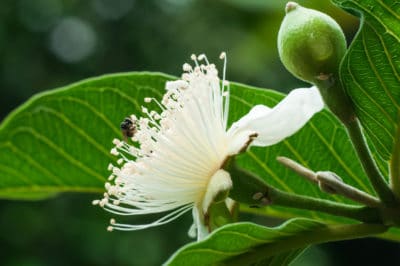Choosing Guava Varieties
A number of guava varieties are available. Some are named cultivars, others are not. These are among the cultivars that are usually available:
- Guava Ruby Supreme
- Indonesian Seedless
- Indonesian White
- Lucknow 49
- Patricia
- Psidium guajava ‘Nana’ (Dwarf Guava)
- Red Malaysian
- Safeda
- Tikal Guava.
Guava Flower Appearance
Most of the guava cultivated for edible use are Psidium guajava. However, a related plant called the pineapple guava, or Feijoa sellowiana ‘Berg,’ is another common form. Most guavas have pure white, five-petaled flowers with long, multiple central stamens. Pineapple guava has red to pink stamens and white petals spotted with pink and lavender. The stamens of both look like a fountain or fireworks display.
Flowering Period
Guava leaves occur in pairs and the flowers are borne at the base of the leaves on wood from the current year’s growth. One to three flowers occur in each leaf node. The flowering period is usually about 20 to 45 days long. The length of bloom is affected by the variety, season and growing region. Fruit appears about 12 days after the tree blooms and takes 90 to 150 days to mature.
Flowers and Pollination
Guavas are usually self-pollinated, although pollination may also occur by insects, primarily the honeybee. Even self-pollinating trees tend to produce more fruit when planted near another guava. A mature tree can set many flowers, of which about 80 to 85 percent actually set fruit. However, due to the normal process of fruit drop, only about 35 percent of the fruits actually mature.
Managing for Flowers and Fruit
Since guava flowers appear on new wood, pruning will not negatively affect and may even stimulate more flower growth. Some growers thin the flowers in order to produce more fruit. Guavas need fertile soil and extra feeding to flower well and produce fruit. Work a 6-6-6-2 fertilizer (the last digit refers to magnesium) around the tree drip line in early spring. Repeat every two months during spring and summer.
Guava Won’t Flower
If your guava won’t flower, the first consideration is maturity. Although some may bloom at two years, three or four is more common. Excessive watering is hard on the tree, which won’t produce flowers if it’s stressed. If you’re growing it in a container, it may be root-bound. A guava that isn’t getting enough sun may also refuse to bloom.
